
“
The collagen and skin elasticity science explains how our skin remains firm, youthful, and resilient through the interaction of structural proteins and cellular processes. Collagen is the most abundant protein in the body and is crucial for maintaining skin's strength and flexibility. Elasticity, on the other hand, allows skin to bounce back after stretching or compression.1
1
”
Collagen makes up approximately 75% of the skin's dry weight. It serves as a structural framework, holding cells together while supporting elasticity, moisture retention, and overall skin firmness. 1
There are at least 28 types of collagen, but Types I, II, and III are most common in the skin. Type I is the strongest, giving skin its tensile strength and smooth texture. 2
Elastic fibers are primarily made from elastin, a protein that allows tissues to stretch and recoil. Without elastin, skin would sag permanently after any movement or compression, losing flexibility. 3

Fibroblasts are specialized cells found in the dermis that produce collagen and elastin. They regulate skin repair, maintain structure, and respond to signals triggered by damage or inflammation
Collagen synthesis begins to slow down in the body as early as age 25. By the time someone reaches 50, collagen production may decrease by up to 30%, affecting skin firmness. 4
Ultraviolet (UV) radiation from the sun breaks down collagen fibers and hinders new collagen formation. This process, known as photoaging, causes wrinkles, rough texture, and pigmentation in exposed skin. 5
Vitamin C is essential in collagen production. It helps stabilize and cross-link collagen molecules, making them structurally sound and resistant to breakdown, especially in the skin’s connective tissue. 6
Smoking introduces chemicals that impair blood flow and damage fibroblasts. This limits oxygen and nutrient delivery to skin cells, reducing collagen production and accelerating wrinkle formation and sagging. 7
Modern dermatologists, like Dr. Murad and Dr. Bowe, emphasize a collagen-focused lifestyle—balanced nutrition, topical retinoids, and stress management—to sustain youthful, elastic skin. 8

A high-sugar diet causes glycation, where sugar molecules bond with collagen. This stiffens the protein, reduces its elasticity, and leads to dull, creased, or saggy skin over time.
Retinoids, derived from vitamin A, are proven to stimulate collagen production. They work by promoting skin cell turnover, which encourages the development of new collagen fibers in the dermis. 9
Hyaluronic acid, though not collagen itself, binds water in the skin and maintains hydration. It creates an ideal environment for collagen and elastin to thrive and remain functional. 10
Collagen isn’t just cosmetic; it also protects skin from tearing or injury. This resilience is why collagen-rich skin heals faster and retains its structural integrity after stress or damage. 11
Elastin production, like collagen, also declines with age. After puberty, elastin fibers are rarely replaced, which means skin slowly loses its bounce and snap-back ability over decades. 12
The dermis, the skin’s thick middle layer, is where collagen and elastin fibers reside. It provides both mechanical support and flexibility, keeping the epidermis stable yet stretchable. 13
Peptides are short chains of amino acids that signal the skin to repair itself. When applied topically, some peptides can stimulate collagen production and improve skin strength and texture. 14

Infrared light therapy has been studied for its ability to stimulate fibroblast activity. It encourages collagen growth by triggering specific cellular pathways linked to tissue repair and renewal.
Marine collagen, usually sourced from fish skin or scales, is absorbed more efficiently than bovine collagen. It supports elasticity by increasing Type I collagen levels and skin moisture retention. 15
Collagen supplements may improve skin elasticity, but only if they’re hydrolyzed into peptides. These peptides are more bioavailable and can stimulate fibroblasts to increase collagen synthesis. 16
The skin renewal cycle takes about 28 days, during which collagen is remodeled. This constant turnover helps the skin adapt to physical demands and environmental changes while maintaining elasticity.17


